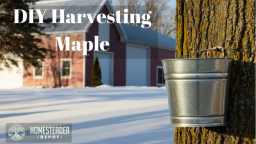Tapping maple trees for sap may seem like a daunting task. However, it really is not hard to do. In fact, this outside activity can be fun as the days get warmer in anticipation of springtime.
But what if you are not sure which trees are maple? Or which maple trees are the best to tap? Be assured that being self-sufficient doesn’t mean you need to be a pro at tapping. Why not start out with tapping just a few trees? You could join in with neighbors or homesteading friends to see if it is something you want to do every year.
The time of year to do the tapping depends on when the temperature warms up over 32 degrees in the day but still freezes at night, generally from February through late March or early April. With the following tips, you’ll be serving homemade pancakes with maple syrup in a matter of a few weeks.
Preparing to Tap
The tools needed are a hammer, a bucket with a cover (or buy a maple pail at the local home improvement store), a drill of some sort, 5/16 or 7/16 drill bit, and a few spiles (or taps). To cook the sap, having two crockpots (a large and a medium size) works best but you can also use large and medium-size pots. You need a colander, some coffee filters, jars for the syrup, and something like a giant pitcher to store the sap.
Finding the Best Maples
If you didn’t get the chance last fall to mark the trees you want to tap, identifying the right type of maple trees by other means is possible with a few tips from us. The best kind of sap to tap comes from the sugar (aka hard, black, or rock) maple and you can tell a sugar maple by the type of branches they have. Their branches are what is called “opposite” as opposed to “alternate” branching. Opposite means the branches shoot out from the stem directly across from each other in opposite directions in a uniform manner, whereas alternate branching means that the branches shoot out from the stem alternating without being directly across from each other. If there are any leaves left on the tree or on the ground to examine, sugar maples are usually big with a smooth outline of the leaf, not real jagged or tooth-like. Don’t worry if you get the wrong kind of maple; you will still get some sap.
Tapping
Look for older large size sugar maples so you can put two or three taps in one tree. You should drill the hole for the spiles on the south side of the tree about at chest height at a slightly upward angle so when you hang the bucket, it won’t slide off the spile. Pound the spile into the hole with the hammer and place the bucket with the cover on it to keep pieces of wood or leaves from getting blown into the sap. To get the sap to start flowing, you may need to blow your hot breath into the spile. Once it starts, you should check the buckets every day and remove sap to store in the fridge until you have enough to start cooking a batch in a large crockpot.
Making Maple Syrup
You should cook the sap within seven days of harvesting it. The best way to prepare sap is in a large crockpot. To strain the sap, place a colander with several coffee filters spread out and flattened to pour the sap through into the crockpot. Fill the crockpot almost full with sap. Bring it to a simmer on high setting and then turn down to low until it has reduced down to half, which will take about eight hours or overnight. If you have more sap to cook, pour the melted amount into another smaller crockpot. Keep on warm until it gets darker and the consistency of syrup. Keep filling the large crockpot with more until you are finished with the season’s amount.
Conclusion
Now, that wasn’t so hard, was it? You may have surprised everyone with more than you expected. If so, you can always have pancakes for breakfast, lunch, and dinner, plus give some away as gifts!





